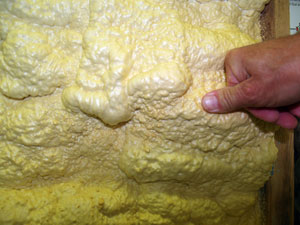In Business Since | License #
In Business Since | License #


Closed cell foam cures dense and hard and is heavier than open cell foam. It forms an effective barrier against both moisture and air.
All types of expanding spray foam insulation are made up of tiny cells or bubbles. In closed-cell formulations, the majority of the cells remain intact and unbroken, even after the foam has expanded and cured. Gas that caused the foam to expand, for the most part, remains inside the cells. The result is a fairly hard, rigid material that can act as a moisture barrier as well as an air barrier.
Closed-cell foams are quite dense. When used for insulation, it ranges from 1.7 lb. per cubic foot to 2 lb. per cubic foot. The greater the density, the stronger the foam. Closed-cell foam is dense enough to strengthen the structure to which it is applied. In fact, studies have shown that it improves the attachment of roof sheathing to rafters and trusses - a real benefit if you live in an area subject to hurricanes and high winds. For roofing, higher density formulations of about 3 lb. per cu. ft. or more are used in order to support traffic and loads.
Closed-cell foam insulation also has a high R-value of 6 to 7 per inch, twice as much or more than fiberglass and other types of blown-in insulation - and 40 percent better than open-cell foam. This makes it ideal for insulating areas where there is limited space for insulation, such as in conventional wall and roof framing. It is also preferred in cases where the insulation may come in contact with water.
If there are small or wet spaces that need insulating in your home, Dr. Energy Saver can apply this closed-cell foam insulation with efficiency and cost-effectiveness. Contact us today to install insulation in your home!
Closed-cell spray foam is available in several forms. Small cans, such as those you can buy at a home center, are ideal for filling small gaps. It can, for example, be used for sealing around electrical boxes and can lights. Kits, consisting of recyclable canisters, hose, and gun, come in 200 and 600 board feet quantities.
They are great for insulating rim joists and ductwork. Both small cans and kits are one-part formulations, so there is no mixing. For larger jobs, such as insulating a roof deck, two-part formulations are used. A specially rigged truck is typically used to mix, deliver and apply the foam.
| Advantages |
|
| Disadvantages |
|
Interested in spray foam insulation but not sure where to start? Look no further - Dr. Energy Saver has the highest qualitty products for your insulation needs. Contact us today to have a certified contractor inspect your home!
Looking for a price? Get a no cost, no obligation free estimate.